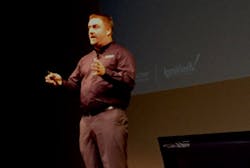Embedding more functionality on plant floor devices has been a growing trend in the automation sector for the past several years. Much of this trend has been evidenced by increasing device power and security capabilities at the chip level. Now, we are beginning to see automation platforms get embedded as well.
At Inductive Automation’s Ignition Community Conference 2017, Travis Cox, co-director of sales engineering at Inductive Automation, announced the upcoming release of Ignition Onboard and Ignition Edge Onboard via partner products. “Automation hardware suppliers can now pre-install Ignition and Ignition Edge on their devices and go to market with it,” said Cox. “Opto 22, with its groov box, and Hilscher, with its netIOT gateways, will be the first to market with this.”
Cox said that the drive behind this new development for Ignition is “to make it easy for industrial end users to get more data from more devices without having to rely on IT to make the necessary connections. With Ignition Onboard, we can provide easy plug-and-play connectivity” to existing devices.
By placing Ignition Edge Onboard on devices such as groov and netIOT, users have a way to connect legacy devices that lack MQTT support to an MQTT message broker for any number of Industrial Internet of Things (IIoT) applications.
As an example, Cox said that with Hilscher’s netIOT with Ignition Edge Onboard, users can plug netIOT into a legacy Allen-Bradley backplane to “eliminate the need to poll the PLC for data. In this way, users get a higher speed of data communication with MQTT while also automatically picking up tag data from the controllers.”
Editor’s note: After partnering with Cirrus Link Solutions, Ignition has had the capability to leverage MQTT to automatically acquire and access all tag data on a system.
Inductive Automation, Opto 22 and Hilscher expect these products with Ignition Onboard to be available between late fourth quarter 2017 and early first quarter 2018. The embedded versions of Ignition Edge on groov and netIOT will also feature free trial versions of Ignition Edge Panel (HMI software) and Ignition Enterprise.
“With OPC UA server on groov we can connect to any PLC without the need for external box,” said Benson Hougland, vice president at Opto 22. “And now, with Ignition Edge Onboard in the groov box, we can take data gathered via OPC UA and publish it directly to an MQTT broker. This means that all the tags groov connects to via OPC UA can now be delivered to Ignition Edge and the rest of the enterprise for a single source of truth.”
He added that Opto 22 is absorbing the cost of adding Ignition Edge into groov as a value-add for their customers. “Ignition Edge Onboard will be available on all Opto 22 groov boxes as a free software update,” said Hougland.
Echoing Cox’s comment about being able to make these device-to-enterprise connections without IT involvement, Hougland noted that groov with Ignition Edge Onboard can also be used to connect remote plants to an MQTT broker with no IT involvement. The reason this is possible, Hougland said, is that “with this connection, it’s just outbound communications. So there are no security concerns and you also have very high-speed performance because of MQTT’s method of reporting by exception.”
Highlighting the positive bandwidth impact of MQTT that makes the protocol so appealing for many companies, Hougland offered an example of an Opto 22 customer that previously used polling (versus MQTT’s publish/subscribe reporting by exception method) to access a remote plant’s PLC data. Before switching to MQTT, this end user incurred costs for cellular transmission of two to three gigabytes of data each month from the remote PLCs. Using MQTT, that end user now only collects three megabytes of data a month.
Craig Lentzkow, IIoT business development manager for Hilscher, explained that the partnership between Inductive Automation and Hilscher around Ignition Edge Onboard makes a lot of sense for both companies and their customers considering the purpose of Hilscher’s netIOT gateways is to be installed on Industrial EtherNet I/O networks as a slave to move data from PLCs. The gateway uses Ignition Edge to access the PLC data and then uses Node-Red to convert the data to MQTT. He added that netIOT can also convert PLC data to other protocols such as AMQP and OPC UA. “Ignition Edge Onboard is what we’re using to push the data into an IT environment,” he said.
This first release of embedded Ignition on the netIOT gateways is focused on Ignition Edge Onboard because of the initial projects Hilscher is working on with Inductive Automation. In these applications no more than 500 tags per device will need to be tracked. “Technologically, it makes no difference to us whether we’re embedding Ignition Onboard or Ignition Edge Onboard, as netIOT could accommodate either version,” Lentzkow said.
Cox added that more announcements about hardware suppliers embedding Ignition Onboard and Ignition Edge Onboard would be forthcoming.
About the Author
David Greenfield, editor in chief
Editor in Chief

Leaders relevant to this article:
